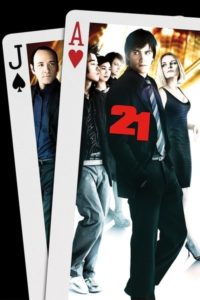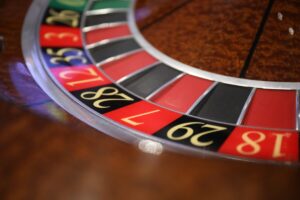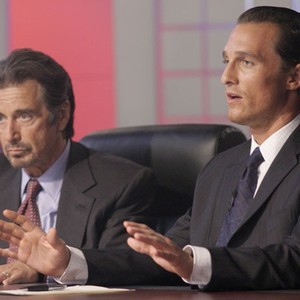 Released by Columbia Pictures in 2008, ’21’ is a slick, stylish crime drama film loosely based on the book, ‘Bringing Down The House’, written by Ben Mezrich, which tells the story of the real-life Massachusetts Institute of Technology (MIT) Blackjack Team. Jim Sturgess stars as brilliant, but down-on-his-luck, mathematics prodigy Ben Campbell, whose admission to Harvard Medical School depends on his ability to raise $300,000 to pay tuition fees. Having impressed statistics professor Micky Rosa, played by Kevin Spacey, by unhestatingly solving the so-called ‘Monty Hall’ problem – a counter-intuitive probabililty puzzle – Campbell is deemed suitable to be trained in the ‘dark art’ of card counting.
Released by Columbia Pictures in 2008, ’21’ is a slick, stylish crime drama film loosely based on the book, ‘Bringing Down The House’, written by Ben Mezrich, which tells the story of the real-life Massachusetts Institute of Technology (MIT) Blackjack Team. Jim Sturgess stars as brilliant, but down-on-his-luck, mathematics prodigy Ben Campbell, whose admission to Harvard Medical School depends on his ability to raise $300,000 to pay tuition fees. Having impressed statistics professor Micky Rosa, played by Kevin Spacey, by unhestatingly solving the so-called ‘Monty Hall’ problem – a counter-intuitive probabililty puzzle – Campbell is deemed suitable to be trained in the ‘dark art’ of card counting.
Based on the principle that a deck rich in tens, court cards and aces is good for the blackjack player, keeping a tally of certain cards as they are played reveals when the odds shift in favour of the player and give a card counter a small advantage, typically between 0.5% and 1.5%, over the house. Although not technically illegal, card counting is heavily discouraged by casinos.
Having passed his initiation at an ‘underground’ casino in Chinatown, downton Boston, Campbell joins four fellow recruits on weekend trips to Las Vegas; using a well-rehearsed system of hand signals and code words they proceed to win hundreds of thousands of dollars playing blackjack. Predictably, despite his honourable intentions, Campbell is gradually corrupted by the high-rolling lifestyle and, ultimately, his arrogance and greed attracts unwanted attention. Events spiral out of control, leading to a final showdown, during which the avaricious Rosa finally gets his comeuppance at the hands of his long-time nemesis, veteran casino security consultant Cole Williams, played by Laurence Fishburne.
The movie was set to be one of the top gambling movies of all time (it did make the top 10 gambling movies in Italy ) but over time it has instead become regarded as one of many gambling flick of modern times..
 Entire volumes have been written about casinos. From stories of the establishments themselves, the history of Vegas, playing strategies and big wins. There’s no shortage of approaches to take with casino Q&As. In this edition though we’ll be centering in on the money (both virtual and real) and the collectibles side of casinos.
Entire volumes have been written about casinos. From stories of the establishments themselves, the history of Vegas, playing strategies and big wins. There’s no shortage of approaches to take with casino Q&As. In this edition though we’ll be centering in on the money (both virtual and real) and the collectibles side of casinos.
What is the highest chip value in use in a Vegas?
This may well be one of those questions without a confirmed known answer, are there are close to 200 separate casinos in Las Vegas, Nevada – 30 of them forming part of the Las Vegas strip. Most casinos offer $1000 chips for those wishing to put their peddle to the mental, gambling-wise. If you sit at a roulette table for any amount of time, no matter the denominations people are betting, you get to see an awful lot of money exchanging hands pretty quickly. For some though, they think beyond the low thousands. Consider the Floyd Mayweather types, making tens of millions of dollars and then not thinking twice about unwinding at a Vegas casino.
After searching high and low for an answer, we’ve settled on the Paris, Las Vegas, which offers a casino chip to the dizzying value of $100,000. It’s not often you’d ever actually see this chip as it’s held back for those with multi million dollar credit lines (arguably more money than sense!). Interestingly, the $100,000 chip which of course sports a RFID security tag, is usually reserved for baccarat. The game is known to attract big money players; Planet Hollywood’s baccarat tables allow a maximum bet of a hefty $200,000!
Can you turn cash to chips and vice versa in Grand Theft Auto’s Diamond Casino?
Lover of the Grand Theft Auto franchise were elated when in July 2019 a fully kitted out casino (Blackjack, Poker, Roulette and more) popped up in the GTA 5 world. The casino, set in the fictional setting of Los Santos, even lets you exchange real money for casino chips, so is as real as can be. Chips can be purchased in-game at the ratio of $1 to 1 chip. Any winnings can then be spent in the GTA world such as on cars or weapons. However, you cannot turn your chips back into real world cash. Whether this will change in future is anyone’s guess. Some though would say that’s it’s not healthy to blur the lines between gaming and gambling. In fact a number of countries have blocked gambling based mini games in the likes of GTA 5 and Red Dead Redemption.
How are casino chips made?
Much in the same way that people are often fascinated by ‘where their money comes from’, many have wondered how casino chips are made. As you might well imagine there is more to them than meets the eye. It’s important for starters that chips are aesthetically pleasing. They are central to casino play and so significant thought goes into the design process, colour scheme and even weight of the chips. The manufacturing is as granular as giving consideration to the sound casino chips make when they are clatter together. They also need to be durable and so size and thickness is a consideration. Worldwide, there are only a handful of trusted companies with the experience to make professional casino chips (Abbiati, Matsui, and Gaming Partners International); rather than the cheap plastic ones you get in home roulette and poker sets.
Chips need to be casino specific and distinctive, so they have all manner of customisation options such as the design, rim, inner/outer section of the chip, and a choice of up to 50 colours. All previous designs are stored in a database to ensure that there are no matches. Underneath the bonnet there’s plenty going on too. Chips routinely sport both UV and RFID tag elements to ensure their authenticity and security.View it as being similar to a watermark on a bank note. So in summing up, a simple casino chip is a lot more complex and planned out than it may look at first glance.
 Anyone with a love of roulette has surely heard of the Martingale system. There is a certain logic and structure behind why it ‘can’ work to your benefit, but it’s a system that is very unforgiving should you find yourself on a losing streak. The principle behind it is very straightforward; betting on red or black you simply double down every time you lose, until your number comes up. It goes like this:
Anyone with a love of roulette has surely heard of the Martingale system. There is a certain logic and structure behind why it ‘can’ work to your benefit, but it’s a system that is very unforgiving should you find yourself on a losing streak. The principle behind it is very straightforward; betting on red or black you simply double down every time you lose, until your number comes up. It goes like this:
- You bet $10 and lose (bankroll at -10).
- You bet $20 and lose (bankroll at -30).
- You bet $40 and lose (bankroll at -70).
- You bet $80 and lose (bankroll at -150).
- You bet $320 and win (bankroll at +10).
This clearly illustrated both the reasoning behind it as well as its fatal flaw. When the going is good you can add to your winnings over time in a very consistent way. However, roulette has some improbably runs of a single colour for instance, and if you find yourself caught in the midst of one of those, you’ll soon be gambling mind boggling amounts in order to simply claw your money back. There are no shortage of horror stories of those pushing things too far with the Martingale system and losing everything. It ‘feels’ like a foolproof system until it suddenly goes off the rails.
Notable individuals with connections to the Martingale system include the likes of David Cloe, an artist who made his millions ($200 million to be precise) via cashing in shares he has given upon completing a Mural in the early days of Facebook. He’s said to have gone from $500 t $1 million on one casino trip. Though to eventually jacked in the gambling on account of suffering an angina attack at just 35 due to his hedonistic party lifestyle.
Another Martingale madman is Charles Wells, the nineteenth century conman who conned people out of £4000 (worth £130,000 today) before gambling with it Monte Carlo. He experienced the run of a lifetime breaking the bank on multiple occasions to the tune of a million francs total (£4 million total). He later returned and repeated the feat! In interviews he proclaimed that he used a secret strategy, only for it later to emerge that he simply used the Martingale system. It proved to be his undoing on his fateful third trip to Monte Carlo. He lost everything and to top it off was arrested for fraud upon his return to Britain.
 Distributed by Universal Pictures in 2005, Two for the Money is a sports drama film starring Al Pacino, Matthew McConaughey and Rene Russo. Brandon Lang (McConaughey) is a former college football star who, after suffering a career-ending knee injury, is reduced to a telemarketing role, predicting football results on behalf of gamblers. Nevertheless, the remarkable accuracy of his predictions attracts the attention of Walter Abrams (Pacino), head of a thriving sports trading websites with its own cable television show called ‘The Sports Advisors’.
Distributed by Universal Pictures in 2005, Two for the Money is a sports drama film starring Al Pacino, Matthew McConaughey and Rene Russo. Brandon Lang (McConaughey) is a former college football star who, after suffering a career-ending knee injury, is reduced to a telemarketing role, predicting football results on behalf of gamblers. Nevertheless, the remarkable accuracy of his predictions attracts the attention of Walter Abrams (Pacino), head of a thriving sports trading websites with its own cable television show called ‘The Sports Advisors’.
Abrams recruits Lang, who moves from Las Vegas to Manhattan, where his whole image is overhauled to create an entirely fictitious, but nonetheless slick, persona, by the name of ‘John Anthony’. Lang, as John Anthony, is added to the roster of regular pundits on ‘The Sports Advisors’, much to the annoyance of previous ‘blue-eyed boy’ Jerry Sykes (Jeremy Piven), and proves an immediate success.
However, seduced by the trappings of his newly-found high-rolling lifestyle, Lang becomes complacent in his work, relying on hunches rather than his knowledge of the game, with predictably disastrous results. At one point, he is physically assaulted by associates of a disgruntled client. Abrams, a recovering, but by no means recovered, alcoholic and gambling addict, soon turns on his protégé and even suspects that Lang is having an affair with his doting wife, Toni (Russo). The relationship between the two men disintegrates, irrevocably, as they try to outsmart each other. Lang does make two successful predictions for the Super Bowl, both made tossing a coin, but leaves Abrams to pursue a less glamorous career, coaching junior league tackle football.
